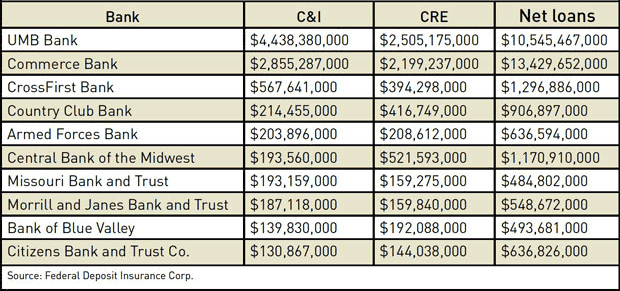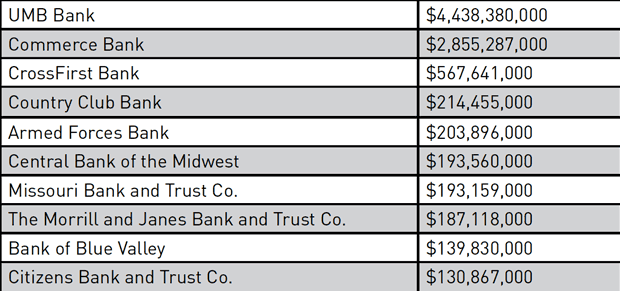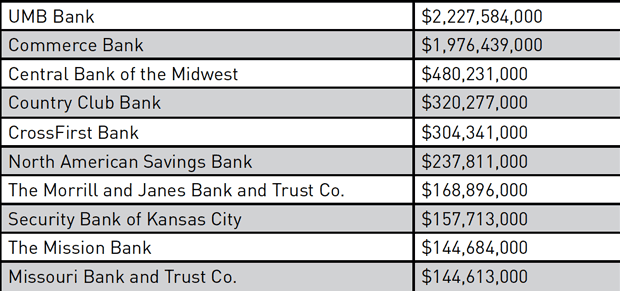HOME | ABOUT US | MEDIA KIT | CONTACT US | INQUIRE
HOME | ABOUT US | MEDIA KIT | CONTACT US | INQUIRE
A precipitous plunge in commercial and industrial bank lending, vital to support business operations, hit the nation in 2016. But bankers here don’t believe the regional economy is at risk of being constrained.
The Great Recession officially bottomed out in the second quarter of 2009, but for many businesses, the weakness of the recovery that followed inspired feelings that the journey to prosperity didn’t get started until 2011—or later.

“If we were just trying to be broad-based and do as the big banks do, theyd eat your lunch.” – Joe Keller, senior vice president and manager of commercial lending, Bank of Labor
“Real estate is booming, but you have to look at a street level, rather than at a region level.” — David Chinnery, president & CEO, Adams Dairy Bank
For anyone paying attention to a pair of key lending metrics compiled by the Federal Deposit Insurance Corp., though, there was plenty of evidence that bank lending was priming the engine for a broader recovery. In
the Kansas City region, as with the nation overall, lending in both the commercial real estate and the C&I category—commercial and industrial—attained some significant gains over the five-year period starting in 2011.
Commercial-real estate tends to produce higher volumes of lending, with good reason: compared to C&I, it’s a lot more reassuring for a banker to lend against a hard asset like property for collateral. C&I, by contrast, relies on a deeper understanding
of a business client’s operations, the true meaning behind its receivables numbers, and other factors. And it’s a vital component of business finance, the tool that many businesses turn to for additional working capital, or to finance expansions and prepare the path for growth.
But in the Kansas City market, C&I lending absolutely shone for five years, nearly doubling in volume—from $5.3 billion to $10.3 billion—before hitting a wall in 2016. That’s when C&I volume growth nationwide ground to a halt—and in fact, pulled back by nearly $350 million in this region, a decline of 3.29 percent.
Is there something about that recent trend that should be of concern to business owners and managers today? Probably not, area bankers say.
“Honestly, things were so stagnant for so long that the run-up was kind of backfilling everything that hadn’t been going on for the previous few years,” says Joe Keller, senior vice president and commercial lending officer for the Bank of Labor. The surge in C&I, he said, had a bit of an artificial tinge to it. “Things didn’t turn around and get fantastic overnight; it was just a lack of what was going on before. There was so much need, so when it all came loose—the old phrase ‘irrational exuberance’ comes to mind—but it really was more backfilling.”
"At the end of the day," he said, "a lot of small companies are doing a little better, but they’re not doing that great. It wasn’t ever going to really sustain at that increased level.”
And yet, Bank of Labor was able to more than quadruple its C&I lending in that period, the fourth-largest growth among Kansas City based banks. Admittedly, Keller says, the base it started from was small—roughly $21 million—but it had a nearly $100 million C&I portfolio by the end of last year.
“For us, it came from a couple of niches we were able to deal in and lend in,” he said. “If we were just trying to be broad-based and do as the big banks do, they’d eat your lunch. So it was important to be able to identify a couple of niches in the equipment-finance area, some contract finance, that are both C&I-type buckets.”
Real-estate lending is vital to any lender, bankers say, because they get more bang for the their buck with collateral that is generally better than other lending categories. “That’s what everybody wants to do.” Keller said.
Mike Hagedorn, CEO of UMB Bank, which grew its lending volumes significantly in both C&I and commercial real-estate lending, noted that after the real-estate crisis of 2008, banks that normally made their living in the CRE space went looking for other lines for growth, contributing to the C&I surge.
“Because the financial crisis was essentially a real-estate crisis, a lot of banks backed away from CRE in 2008,” he said. UMB itself saw its gross loan volumes surge from $3.99 billion in 2011 to $10.5 billion in 2016, in part because of strategic moves to promote organic growth, and in part because of key acquisitions. Within that, its C&I lending went from $1.7 billion to $4.4 billion, and that $2.7 billion bump accounted for more than half the region’s $4.9 billion increase.
But he heard a few years ago from other bankers who said C&I might be the way to go after the real-estate downturn, and what he heard wasn’t promising.
“C&I is the center of the universe, the thing that we do and that we’ve done the longest,” he says. “It’s very profitable for us, the heart of what we do, and we’ve been doing it for 104 years. Post-financial crisis, the thing that worried me was, they said ‘you don’t lose on C&I, only real-estate,’ and that’s not true.”
Banks that succeed in the C&I space, he said, have an intimate knowledge of a borrower’s business model and market conditions. “If you do it the right way, it takes a lot of monitoring, and you have to have very good people.”
As he assesses the regional market, Hagedorn isn’t optimistic that a resumption of C&I growth is in the cards.
“We have some large clients, and midsize, all sizes, really, but that group in particular, the small, they are the bulk of C&I outstanding loans,” Hagedorn said. “Post-2008, they unequivocally have not been borrowing in any material way—that utilization rate has been very flat. That is a bellwether thing that UMB and our management team look at to determine whether the economy is robust. If we see consecutive quarters of increases in the utilization rate, that would be a very good sign.”
Despite a quadrupling of its C&I volumes from 2011 to 2016, which made Adams Dairy Bank the third-largest percentage growth leader in that category, president and CEO David Chinnery says the growth in that category wasn’t out of the ordinary—it tracked with overall growth for a comparatively young bank founded near the epicenter of the recession, 2008.
“C&I growth has come to our bank rather organically, matching our overall growth,” he said. “C&I as a specific product has not been a huge focal point for us. Blue Springs, compared to many other areas of the city, has less commercial and industrial opportunities that need this type of lending.”
"But since 2011," he said, "there has been a lot of cash in the economy, especially among Adams Dairy’s successful commercial clients, so demand for operating lending is not any greater than any other time in our history and we don’t expect that to change in the near future.”
These area banks were market leaders in commercial and industrial lending in 2016, and for many, their C&I volumes rivaled, and even outpaced, commercial real-estate lending:

The drop in business lending might fly in the face of conventional wisdom grounded in surveys that show small-business optimism roaring out of the gate since the presidential election in November. But that wisdom, bankers say, is unfounded.
“We don’t see a direct correlation between optimism and borrowing,” Chinnery says. “Business owners are always cautiously optimistic, but that doesn’t impact their borrowing decisions. With cash in-hand, our commercial clients are still growing and expanding. They just aren’t borrowing in the same manner as in the past. C&I lending for operations has slowed while real estate is booming.”
He also noted a long-term change in attitudes since the economic downturn. “Lending and borrowing became more conservative, in a good sense,” Chinnery said. “Contrary to what some might read, banks have money to lend. We certainly do. We just make very good loans to minimize the risk to our stockholders. I think business and banks alike have this attitude regarding borrowing and lending.”
In some ways, bankers say, the wringing out of marginal businesses brought on by the recession has left behind a commercial environment of stronger companies who, though considerably more credit-worthy as a group, are in the somewhat ironic position of not needing to borrow.
“Post-crisis, almost collectively across our footprint, the survivors are better run, better capitalized, and better cash-rich, which is not a bad thing,” said Hagedorn. To really move the lending needle, more companies need to go all-in, he said, buy equipment and hire more people to grow. But something’s missing to fire that engine.
“Business loves certainty, but the reality is that for three decades now, there’s never been any certainty in the banking space,” he said. Rather, it is the direction that certainty or uncertainty is taking during an economic cycle.
“We know tax rates will change, but how is it going to get done?” Hagedorn said, noting the disparity on top margin al rates that float around in news reports from Washington. “We saw the Trump Bump, but now there’s a wane in the equity markets, partly with other geopolitical stuff going on.”
Add on uncertainties about costs—particularly with healthcare and revisions to the Affordable Care Act and its promised changes through the American Healthcare Act—and it’s hard for a business owner to think about expanding, even if conditions like comparatively low interest rates are signaling that it’s go-time.
Looking forward, Chinnery anticipates overall growth, in part because at present, “real estate is booming, but you have to look at a street level, rather than at a region level.” Banks in the Crossroads, he said, should see the benefit of a booming Main Street corridor, and there’s no slowing down in western Wyandotte County, south Overland Park, or portions of Lee’s Summit, in particular. “I have no reason to believe that commercial real estate will slow any time soon,” he said.
The reason? Real estate remains an unusually attractive investment. “Interest rates are low and will continue to remain low in the foreseeable future,” Chinnery said. “The stock market is showing some volatility. For those sitting on cash, real estate is the place to be. Cap rates are extremely attractive and land is hot. In fact, some banks are liquidating their own real estate to take advantage of a hot market.”
One thing working in favor of land deals here, Keller noted, is the vast disparity in price between property in Kansas City and on the larger and coastal markets.
“We do some lending, even though we’re more of a local bank, but some on a nationwide level in a certain niche we have,” he said. “Land prices and build ing costs are much more in a lot of other places. A building that’s $10 million or $15 million here is certainly going to be $20 million or $30 million somewhere else. That drives those CRE loan volumes up that much more.”
Among Kansas City-based banks, these are the leaders in Commercial and industrial Lending through the end of 2016:

These are the leaders in Commercial Real Estate Lending through the end of 2016:
